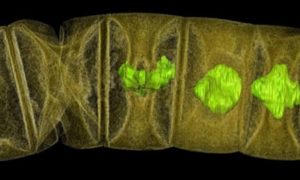
A new study carried out by a team of scientists at the Swedish Museum of Natural History suggests that a pair of 1.6-billion-year-old fossils discovered in India could be the oldest plant-like life discovered on Earth.
This fossil contained red algae, according to scientists. The oldest known red algae, until now, was about 1.2 billion years old.
The fossils were found in sedimentary rocks at Chitrakoot in India. Two kinds of fossils were found—one thread-like and the other consisting of fleshy colonies. Scientists could identify distinct inner cell structures in these fossils. Other structures identified were cell fountains, and bundles of packed and splaying filaments.
“The ‘time of visible life’ seems to have begun much earlier than we thought,” said lead author Stefan Bengtson, professor emeritus of paleozoology at the Swedish Museum of Natural History.
“You cannot be a hundred per cent sure about material this ancient, as there is no DNA remaining, but the characters agree quite well with the morphology and structure of red algae,” Bengtson added.
The earliest traces of life on Earth are single-celled organisms, which are at least 3.5 billion years old. These organisms lack nuclei and other organelles.

The supposed red algae in 1.6 billion-year-old Indian phosphorite lie embedded in fossil mats of cyanobacteria (stromatolites). Researchers first discovered the thread-like forms and then more complex, fleshy structures were found by doctoral student Therese Sallstedt.
“I got so excited I had to walk three times around the building before I went to my supervisor to tell him what I had seen!” Sallstedt says.
Researchers used synchrotron-based X-ray tomographic microscopy technique to look inside the algae, and observed regularly recurring platelets in each cell.
“They show us that advanced life in the form of eukaryotes (like plants, fungi and us humans/animals) have a much deeper history on Earth than what we previously have thought,” Sallstedt told BBC News.
The detailed findings of the study have been published in the open access journal PLOS Biology.
